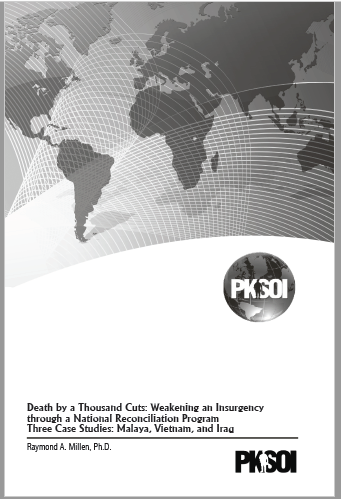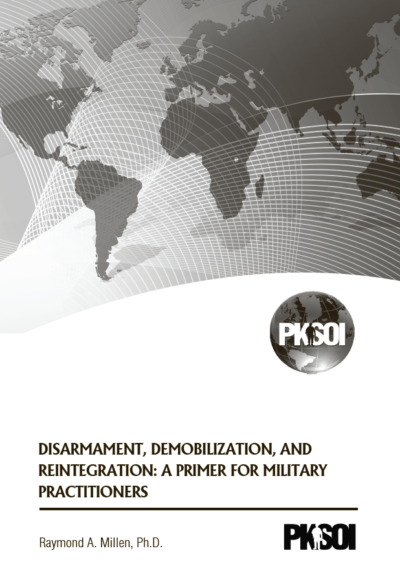Military Support to Governance and the Rule of Law in Fragile States in the age of Pandemics

04.28.2020
Photo bySpc. Jeffery Harris
982nd Signal Company (Combat Camera) (Airborne)
June 2, 2020
By Anthony S. Lieto and the PKSOI Team
The Department of Defense Directive 3000.05 titled Stabilization identifies that stabilization is an inherently political endeavor and requires aligning U.S Government efforts to create conditions to peaceably manage conflict and prevent violence. The Department of State is the overall lead for Governance and other stabilization efforts. The tasks and actions of the U.S. military in support of governance is to assist other U.S. governmental agencies, mainly the Department of State, to aid foreign nations and their people to share, access, and voice their opinion through non-violent processes and enjoy the collective benefits and services of their nation (JP 3-07). External and internal pressures placed on a nation in crisis can disrupt governance and cause unintended consequences. Disease, pandemics, or other medical disruptions to the balance within a nation, especially a fragile nation, can cause assistance by donor nations or international organizations, if not synchronized, to overwhelm the ability of the nation to absorb this assistance (Development, Concepts and Doctrine Centre, Joint Doctrine Publications 3-40). For example, the drought, death, and disease of the livestock in Somalia caused a famine which caused the governance structure within Somalia to collapse and the result was the rise of the warlords. International organizations and military support were not well synchronized or coordinated. The lack of a coordinated and synchronized relief effort caused the governance structure to collapse, warlords took control, and the result was a suffering population. The current ongoing conflict in Yemen with famine, diseases, like cholera, and malaria, has decimated the health care system and caused the disintegration and splintering of the Yemeni government (ICRC Report). Governance within Yemen has ceased to exist. Similarly, the ongoing COVID 19 virus has the potential to cause major disruptions in the governance in fragile nations.
The question exists, what is meant by Good Governance and what effect does Governance have on fragile states? The concept of governance is not new. Governance means the process of decision-making and the process by which decisions are implemented or not implemented (UN-ESCAP). Joint Publication 3-07 Stability, identifies Governance as the nation’s ability to serve the citizens through the rules, processes, and behaviors by which interests are articulated, resources are managed, and power is exercised in a society (i.e., rule of law). The government of a nation is only one of the aspects of governance. In rural areas governance may include landlords or tribal leaders who establish rules and behaviors, manage resources, and exercise power, while governance within urban areas remains more complex. Currently, according to several views, good governance has eight major characteristics. These characteristics include participatory, consensus oriented, accountable, transparent, responsive, effective and efficient, equitable, and inclusive and follows the rule of law. JP 3-07 provides more guidance on stable governance which provides economic activity, a public sector strategy, a public sector management, a governmental structure, civil society participation and voice, and political accountability which is the foundation on which rule of law and economic activity can thrive and become drivers of security and stability.
So how does governance within a fragile nation deal with Pandemics? Pandemics are large-scale outbreaks of infectious disease that increase morbidity and mortality over a wide geographic area and cause significant economic, social, and political disruption to the balance of effective, efficient, inclusive, and responsive governance. History and recent events with Ebola, SARS, MERS, and COVID 19 suggest that the likelihood of other pandemics will occur because of increased global travel and integration, urbanization, changes in land use, and greater exploitation of the natural environment (African Risk Capacity 2016). These trends will continue and intensify causing governance in fragile nations to absorb the consequences and suffer the effects if not prepared. Fragile nation’s policy should focus on the characteristics of “good governance” and the need to identify and limit the damage pandemic outbreaks can cause to the governmental institutions, social structure, and to the security capability and capacity within the nation. Fragile nations should not assume donor nations or international organizations will provide timely, coordinated, and synchronized support and assistance.
Pandemic Social and Political Impacts to Governance
Epidemics and pandemics have significant social and political consequences, creating clashes between nations and citizens, eroding a nation’s capacity, driving population displacement, and heightening social tension and discrimination (ASPR, 2014). Historically, some significant social and political upheaval was associated with pandemics or diseases. The death rates and the resulting demographic shifts resulted in governance institutions collapsing. The introduction of smallpox, typhoid, malaria, and other diseases led to the collapse of governance, national institutions and weakened the societies within a nation’s military capacity and capability to provide security to the extent that the nations were vulnerable to conquest (Diamond 2009). With the improvements in medicines, preventions, cures, and care, recent diseases and pandemics did not result in such dramatic effects on governance institutions specifically political and social instability, because the potential population was informed, took precautions, and received international assistance.
Evidence and recent studies suggest that epidemics and pandemics can amplify existing political tensions and spark unrest, particularly in the governance of fragile states with legacies of violence and weak institutions. During the 2014 West Africa Ebola epidemic, steps taken to mitigate disease transmission, such as quarantines and curfews by security forces, were viewed with suspicion by segments of the public and opposition political leaders. This led directly to riots and violent clashes with security forces (McCoy 2014). In Liberia political tensions from warring factions reemerged early in the epidemic and were linked with threats to health care workers as well as attacks on governance institutions specifically public health personnel and facilities. The Ebola epidemic amplified political tensions in Guinea, Liberia, and Sierra Leone. In Sierra Leone, quarantine in opposition-dominated regions was delayed because of concerns that it would be seen as politically motivated (ICG 2015). Poor governance in countries with high levels of political polarization, recent civil wars, or weak government institutions, a sustained pandemic or outbreak can lead to overwhelming pressure and political tensions impacting the governance structure of the nation.

04.24.2020
Photo by Sgt. Briaira Tolbert
1st Armored Division Sustainment Brigade
Pandemics also can have longer-term impacts on a nation’s security capability and capacity. In the 1990s and early 2000s extremely high HIV/AIDS prevalence rates among African militaries, led to increased absenteeism, decreased military capacity, and decreased readiness (Elbe 2002). Similar effects on security within the governance framework can reduce a nation’s capacity to manage stability, thereby increasing the risks of civil war and other forms of violent conflict.
Large-scale outbreaks of infectious disease have direct and consequential social impacts which can lead to rapid population migration. Sudden population movements have destabilizing effects on governance, and migrants face elevated health risks arising from poor sanitation, poor nutrition, and other stresses. Migration also poses the risk of further spreading an outbreak, one just has to look at the migrate issues facing southern Europe.
The majority of threats to governance originate in nation’s where the citizens do not see their government as legitimate, or where legitimate governments are unable to extend their lawful powers across their entire geographies (JP 3-07). The lack of legitimate governing institutions (governance) are an invitation for illicit forces. Terrorists find their greatest safe haven in countries where governments cannot or will not control their territory. Pandemic diseases which go undetected and untreated due to governments not properly addressing health care needs are an invitation for organized criminal groups to create networks when corrupt governments are complicit (corruption) or unable to take steps to mitigate the threats (inadequate security). The missing links in all of these cases are legitimate governing institutions that reflects the will of the people, responds to their needs, and extends their authority across the entire populace, in essence good governance.
Way Forward:
The United States will always take immediate action to address urgent dangers in order to mitigate major threats before they arise—and to sustain global support for the institutions of good governance. The following three steps are recommended for providing good governance and the rule of law fragile states, in cooperation with to partner nations whose stability is in the U.S. national interest. These steps are a composite outlined in JP3-07, FM 3-07 and UN publications. The U.S. military’s support to governance effort is listed below.
The United States must help strengthen the legitimacy of fragile states across the world and focus efforts in particular on supporting willing partner countries whose instability and fragility could pose direct threats to U.S. national security.The U.S. military uses its extensive security cooperation network and enterprise to assist nations with security force assistance.
States that cannot prevent threats from taking root within their borders must be supported by the United States in partnership with the rest of the world—with other donor nations, international organizations, and private sector entities. The U.S. military can provide coordination, synchronization, and C2 assets to assist.
Support the Rule of Law with nations that enjoy true legitimacy, internal support for the system of government expressed voluntarily by the people.Supporting these nations who have good governance characteristics would require channeling U.S. resources and diplomacy toward bolstering these fragile nations. The U.S. military support elements could include, legal support to a recognized justice and dispute resolution system perceived as fair (rule of law), engineer support to provide basic services for its citizens, medical and veterinary teams to mitigate disease, military training teams to assist local security forces, and ministerial advisors to governing security forces and their institutions.
Endnotes:
ARC (African Risk Capacity). 2016. “African Risk Capacity Strategic Framework 2016–2020.” Strategy and policy document, ARC, Johannesburg, South Africa.
ASPR (Assistant Secretary for Preparedness and Response). 2014. “Public Health and Medical Situational Awareness Strategy.” Strategy document for situational awareness implementation plan U.S. Department of Health and Human Services, Washington, DC.
Diamond J. 2009. Guns, Germs, and Steel: The Fates of Human Societies. New York: Norton.
McCoy T. 2014. “Why the Brutal Murder of Several Ebola Workers May Hint at More Violence to Come.” Washington Post, September 19.
Elbe S. 2002. “HIV/AIDS and the Changing Landscape of War in Africa.” International Security.
ICG (International Crisis Group). 2015. The Politics behind the Ebola Crisis. Crisis Group Africa Report 232, International Crisis Group, Brussels, October 28.
Ministry of Defence, 2010, Joint Publication 3-40, Security and Stabilization: The Military Contribution, Shrivenham, UK.
United Nations, Economic and Social Commission for Asia and the Pacific, 2012, ‘What is Good Governance,” Bangkok, Thailand.
Joint Publication 3-07, 2016, Stability, Washington DC.
DoD Directive 3000.5, Stabilization, Office of the Under Secretary of Defense for Policy, December 13, 2018.
























